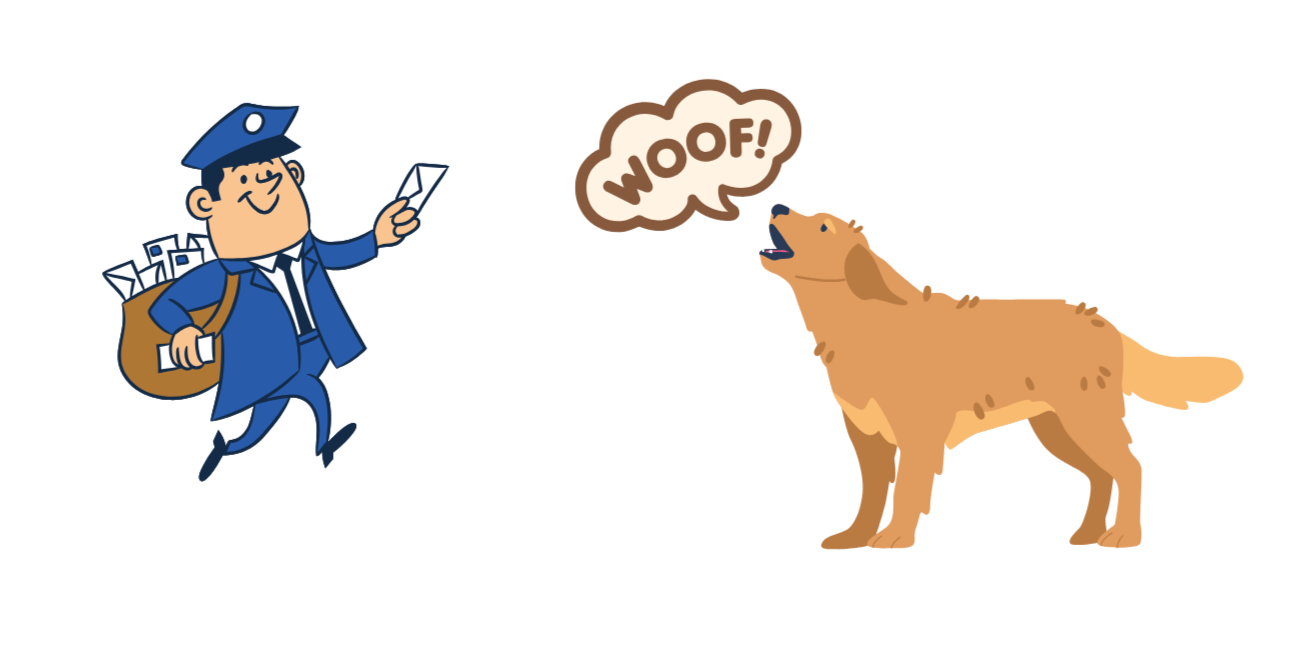Safety-behaviours:
The secret threat to your mental health
Safety behaviours:
Safety behaviours are any action you may be tempted to use to prevent your fear from happening or to reduce your anxiety. They act like a safety net to prevent your fear. While they seem harmless or even helpful, these behaviours actually feed your Emetophobia. This is because they can convince you that the worst would have happened if you did nothing to prevent your fear.
Let’s demonstrate this using an analogy I like to call “barking at the postman”.
If you already understand this, click here to go to examples of safety-behaviours.
“Barking at the postman”
We all know that most dogs bark at the postman. Lets imagine a dog who is scared of the postman. When the postman comes close to the house, the dog perceives a threat. The dog thinks that the postman is going to break in or is a danger in some way.
So the dog barks!
And the postman walks away.
The dog congratulates himself on getting rid of the threat. He learnt that barking keeps the postman away. Good boy!
However, we all know the postman would have walked away on his own. Each time the dog sees the postman he still sees him as a threat and barks. He thinks his barking is working.
Now imagine you could speak with dogs and you ask him to take a “risk” and not bark at the postman for the week.
The dog see’s the postman coming and does not bark. To his surprise the postman posts his letter and walks away… He thinks “maybe I got lucky, I am sure he will break in next time”.
The day next comes, and the next day after that. The dog doesn’t bark and the postman still hasn’t broken in. Soon the dog realises he was wrong and that the postman was not trying to break in.
Key message:
When we use our safety behaviours we never get to see what would have happened if we did nothing. We are barking at the postman even when he was going to walk away anyway.
So, we need to test out our predictions of what will happen by facing our fear without trying to prevent it.
Safety behaviours only keep you trapped feeling anxious, even when nothing bad happens.
Types of safety behaviours:
Almost anything can become a safety behaviour. However, they usually fall into one or more of these five main categories:
1) The first category is to prevent your fear by not being there or taking the chance of it occurring. This is done in two ways: Avoidance and Escape behaviours.
2) The second category is related to verifying if your fear is occurring or going to occur or not. This is also done in two ways: Checking and Reassurance seeking.
3) The third category is to directly try to prevent the feared outcome from occurring or to mitigate how bad it will be.
4) The fourth category is called neutralisation and relates to trying to deal with the impact of negative thoughts.
5) The last category is called “Accommodation”. This is when others start using safety behaviours on your behalf. This can either be because you have asked them to, or out of their kindness to try and reduce your anxiety. Although well-meaning, this feeds your anxiety over time.
Read on, or click a specific section:
Avoidance and Escape:
This type of safety behaviour is easy to understand. It is the act of avoiding or leaving (escaping) situations, people, places, things or anything that triggers you.
Examples of avoidance and escape behaviours:
-Avoiding situations where vomiting might occur.
-Avoiding certain foods or drinks.
-Avoiding public transportation.
-Refusing to eat out at restaurants.
-Avoiding hospitals or medical facilities.
-Avoiding watching TV shows or movies that might depict vomiting.
-Avoiding children or pets.
-Refusing to travel.
-Avoiding certain smells.
-Avoiding becoming pregnant.
-Avoiding certain cooking methods.
-Avoiding attending social gatherings or parties where alcohol is consumed.
-Avoiding visiting amusement parks or going on rides that could cause motion sickness.
-Avoiding participating in sports or physical activities that might lead to nausea.
-Avoiding going to concerts or crowded events where you might feel trapped.
-Avoiding using elevators or escalators due to the fear of feeling dizzy.
-Avoiding taking medications that list nausea as a potential side effect.
-Avoiding being around people who are sick or have recently been ill.
-Avoiding eating at buffets or where food hygiene is uncertain.
-Avoiding traveling by airplane due to the fear of air sickness.
-Avoiding going on boats or cruises where motion sickness is a risk.
-Avoiding visiting places with strong or unusual smells.
-Avoiding engaging in activities that involve spinning or rapid movement.
-Avoiding trying new or unfamiliar foods.
-Avoiding attending school or work during flu season.
-Avoiding using public restrooms due to concerns about cleanliness.
-Avoiding being in environments where they cannot easily leave if they feel unwell.
-Avoiding going to the gym or fitness classes where you might overexert themselves.
While all of these things can be avoided, many can also be “escaped” from. Escape is the act of leaving a situation or stopping as soon as you become anxious.
Verification behaviours:
This type of safety behaviour involves attempting to confirm whether your fear is happening or is likely to happen. This is typically achieved through checking behaviours or seeking reassurance.
Examples of verification behaviours:
Checking:
-Checking expiration dates obsessively.
-Monitoring bodily sensations excessively.
-Excessive internet searching about vomiting.
-Checking for signs of illness in others.
-Checking the cleanliness of food preparation areas.
-Checking food is cooked before each bite.
-Constantly checking for signs of nausea or stomach discomfort.
-Continuously monitoring the cleanliness of their surroundings.
-Continuously checking your pulse or heart rate for signs of anxiety.
-Constantly monitoring your diet and avoiding foods that might cause nausea.
-Regularly checking the bathroom for cleanliness before using it.
-Continuously monitoring your body temperature for signs of illness.
-Constantly checking your surroundings for potential triggers of nausea.
-Continuously checking your medication for potential side effects.
-Constantly monitoring your physical activity levels to prevent overexertion and nausea.
Reassurance-seeking:
-Constantly asking friends or family if they look pale or unwell.
-Frequently seeking confirmation from others that they are not sick.
-Asking for reassurance if foods are safe to eat.
-Googling the safety of places, situations, foods or activities.
-Asking for reassurance on online forums.
-Repeatedly asking for reassurance that the food you are about to eat is safe.
-Continuously asking others if they feel nauseous or unwell.
-Regularly seeking reassurance that your surroundings are clean and free of germs.
-Frequently asking for confirmation that you do not have a fever or other symptoms.
-Constantly seeking reassurance that you will not get sick in certain situations.
-Continuously seeking reassurance that you will be able to leave a situation if you feel unwell.
-Regularly asking for confirmation that you are not overexerting yourself.
-Frequently seeking reassurance that your medication will not cause nausea.
-Repeatedly seeking reassurance that you will not encounter any triggers of nausea.
-Continuously asking for confirmation that you are not in an environment where you might feel trapped.
-Regularly seeking reassurance that you are not exposed to potential illness triggers.
Prevention
This type of safety behaviour involves attempting to prevent nausea, gaging, dizziness, anxiety, becoming ill, the act of vomiting or any other fear you have.
Examples of safety behaviours designed to prevent your fear occurring:
-Only eating “safe” foods.
-Only eating small, frequent meals to prevent an upset stomach.
-Drinking ginger tea or taking ginger supplements to soothe nausea.
-Using anti-nausea medication regularly.
-Keeping a glass of water nearby to sip on.
-Chewing gum or sucking on mints to alleviate nausea.
-Practising deep breathing exercises to calm anxiety.
-Using hand sanitiser frequently to prevent illness.
-Excessive cleaning or desensitising.
-Taking motion sickness medication before travelling.
-Using essential oils or scented products to counteract unpleasant smells.
-Using a stress ball or fidget toy to manage nervous energy.
-Using air fresheners to overcome any unpleasant smells linked to nausea.
-Keeping medication readily available “just in case”.
Neutralisation
Many of those with Emetophobia are distressed by having thoughts or images related to vomiting and try to get rid of them by “neutralising” them. Neutralisation is the voluntary act of trying to distract, eliminate, prevent, or fix the perceived consequence of an obsessional thought or the discomfort associated with having the thought.
Examples of Neutralisation
-Distraction.
-Thought suppression (pushing away a certain thought).
-Substituting one thought or image with another one in your mind.
-Keeping busy to avoid thoughts.
-Repeatedly counting in your head.
-Self reassurance.
-Positive affirmations.
-Repeating phrases.
-Compulsively praying.
-Over analysing thoughts or feelings.
-Mentally reviewing actions or situations.
Accommodation
Accommodation is when family or friends attempt to assist to reduce the suffering of the individual with anxiety by participating in safety-seeking behaviours by providing reassurance, helping them check or avoid certain triggers. While often well intentioned, accommodation can inadvertently reinforce anxiety symptoms.
Examples can include most of the behaviours outlined on this page.
“How do I break free from these safety-behaviours?”
Visit my free self-help page to get started.
Click the image below!
My name is David Kaneria and I am an emetophobia specialist and author of:
To stay in the loop, please follow me on the social media of your choice.
Social links are the footer below!
“I need more than self-help!”
If you feel you need to speak to a therapist to help you overcome your emetophobia. Look no further. Send me an email or book your first session today!














